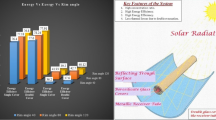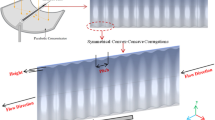Abstract
Entropy generation in the receiver tube of a parabolic trough solar collector can mainly be attributed to the fluid friction and finite temperature differences. The contribution of each of these components is investigated under different circumstances. Mass flow rates, tube diameters and operating pressures are investigated to obtain good guidelines for receiver tube and plant design. Operating pressures between 3 MPa (saturation temperature of 233.9 °C) and 9 MPa (saturation temperature of 303.3 °C) were investigated. Results show that small diameters can result in excessive fluid friction, especially when the mass flow rates are high. For most cases, tube diameters beyond 20 mm will exclusively be subject to entropy generation due to finite temperature differences, and entropy generation due to fluid friction will be small to negligible. Increasing the concentration ratio will decrease entropy generation, due to a higher heat flux per unit meter. This will ultimately result in shorter receiver tube lengths. From a simulated annealing optimization it was seen that if the diameter is increased, the entropy generation can be lowered, provided that the concentration ratio is kept constant. However, beyond a certain point gains in minimizing the entropy generation become negligible. The optimal operating pressure will generally increase if the mass flow rate is increased. Finally it was seen that higher operating pressures are more advantageous when the entropy generation minimization is considered in conjunction with the work output.
















Similar content being viewed by others
Abbreviations
- A :
-
Area (m2)
- A s :
-
Tube exposed heat transfer area (m2)
- C R :
-
Concentration ratio
- D :
-
Diameter (m)
- E :
-
Exergy (W)
- f :
-
Friction factor
- \(\dot{G}\) :
-
Mass velocity (kg/m2 s)
- h :
-
Heat transfer coefficient [W/(m2 K)]
- I b :
-
Solar beam radiation (W/m2)
- k :
-
Thermal conductivity [W/(m K)]
- L :
-
Length (m)
- \(\dot{m}\) :
-
Mass flow rate (kg/s)
- Nu :
-
Nusselt number
- P :
-
Pressure (Pa)
- Pr :
-
Prandtl number
- Q :
-
Heat (W)
- Re :
-
Reynolds number
- S gen :
-
Total entropy generation (W/K)
- S gen,dT :
-
Entropy generation due to finite temperature differences (W/K)
- S gen,dP :
-
Entropy generation due to fluid friction (W/K)
- S r :
-
Reflected solar energy (W/m2)
- T :
-
Temperature (°C or K)
- V :
-
Velocity (m/s)
- W a :
-
Aperture area (m)
- x :
-
Quality (% or fraction)
- ε :
-
Emissivity
- ε void :
-
Void fraction
- η opt :
-
Optical efficiency (%)
- μ :
-
Dynamic viscosity (kg/m s)
- v :
-
Local specific volume (m3/kg)
- ρ :
-
Density (kg/m3)
- σ :
-
Stefan–Boltzmann constant [W/(m2 K4)]
- Φ2 :
-
Two-phase flow multiplier
- amb :
-
Ambient
- cb :
-
Convective boiling
- cond :
-
Conduction
- conv :
-
Convection
- des :
-
Destroyed
- fluid :
-
Working fluid
- G :
-
Vapour
- g :
-
Glass
- gi :
-
Glass inner
- go:
-
Glass outer
- in :
-
Inlet
- L :
-
Liquid
- nb :
-
Nucleate boiling
- out :
-
Outlet
- r :
-
Receiver
- rad :
-
Radiation
- ri :
-
Receiver inner
- ro :
-
Receiver outer
- sky :
-
Effective sky
- sun :
-
Apparent sun
- tp :
-
Two-phase
- wind :
-
Wind
References
Eck M, Zarza E, Eickhoff M, Rheinländer J, Valenzuela L (2003) Applied research concerning the direct steam generation in parabolic troughs. Sol Energy 74:341–351
Price H, Lüpfert E, Kearney D, Zarza E, Cohen G, Gee R, Mohoney R (2002) Advances in parabolic trough solar technology. J Sol Energy Eng 124:109–125
Liu QB, Wang YL, Gao ZC, Sui J, Jin HG, Li HP (2010) Experimental investigation on a parabolic trough solar collector for thermal power generation. Sci China Tech Sci 53:52–56
Odeh S, Morrison G, Behnia M (1998) Modelling of parabolic trough direct steam generation solar collectors. Sol Energy 62:395–406
Forristall R (2003) Heat transfer analysis and modelling of a parabolic trough solar receiver implemented in engineering equation solver. Technical Report; National Renewable Energy Laboratory
Roesle M, Coskun V, Steinfeld A (2011) Numerical analysis of heat loss from a parabolic trough absorber tube with active vacuum system. J Sol Eng 133:1–5
Koroneos C, Spachos T, Moussiopoulos N (2003) Exergetic analysis of renewable energy sources. Renew Energy 28:295–310
Singh N, Kanshik S, Misra R (2000) Exergetic analysis of a solar thermal power systems. Renew Energy 19:135–143
Bejan A (1996) Entropy generation minimization: the method of thermodynamic optimization of finite size systems and finite time processes. CRC Press, Boca Raton
Ratts E, Raut A (2004) Entropy generation minimisation of fully developed internal flow with constant heat flux. J Heat Transf 126:656–659
Sahin A (2000) Entropy generation in turbulent liquid flow through a smooth duct subjected to constant wall temperature. Int J Heat Mass Transf 43:1469–1478
Revellin R, Lips S, Khandehar S, Bonjour J (2009) Local entropy generation for saturated two-phase flow. Energy 34:1113–1121
Barlev D, Vidu R, Stroewe P (2011) Innovations in concentrated solar power. Sol Energy Mat Sol Cells 95(27):3–25
Gnielinsky V (1976) New equations for heat and mass transfer in turbulent pipe and channel flow. Int Chem Eng 1(2):350–367
Petukhov B (1970) Heat transfer and friction in turbulent pipe flow with variable physical properties. Adv Heat Transf 6:503–564
Wojtan L, Ursenbacher T, Thome J (2005) Investigation of flow boiling in horizontal tubes part 1: a new diabetic two-phase flow pattern map. Int J Heat Mass Transf 48:2955–2969
Wojtan L, Ursenbacher T, Thome J (2005) Investigation of flow boiling in horizontal tubes part 2: development of a new heat transfer model for stratified-wavy, dryout and misty flow regimes. Int J Heat Mass Transf 48:2970–2985
Kattan N, Thome JR, Favrat D (1998) Flow boiling in horizontal tubes: part 1—development of a diabatic two-phase flow pattern map. J Heat Transf 120:140–147
Zürcher O, Favrat D, Thome JR (2002) Evaporation of refrigerants in a horizontal tube: an improved flow patter dependent heat transfer model compared to ammonia data. Int J Heat Mass Transf 45:303–317
Churchill S, Bernstein M (1977) A correlating equation for forced convection from gases and liquids to a circular cylinder in cross-flow. J Heat Transf T ASME C 99:300–306
Kalogirou S (2009) Solar energy engineering: processes and systems. Elsevier, Amsterdam
Garcia-Valladares O, Velázquez N (2009) Numerical simulation of parabolic trough collector: improvement using counterflow concentric circular heat exchangers. J Heat Mass Transf 52:597–609
Thome J (2004) Wolverine tube heat transfer data book III. Wolverine Tube Inc. http://www.wlv.com
Friedel F (1979) Improved friction pressure drop correlations for horizontal and vertical two-phase pipe flow. European two-phase flow group meeting, Ispra, Italy, Paper E2
Coolprop BI (2013) http://coolprop-sourceforge.net
Python Software Foundation. Python (2011) http://www.python.org/doc/
Scipy Community. Scipy (2011) http://docs.scipy.org/doc/
Acknowledgments
We would like to thank the University of Pretoria, University of Stellenbosch, NRF, TESP, SANERI/SANEDI, CSIR, EEDSM hub and NAC for the funding during the course of this work.
Author information
Authors and Affiliations
Corresponding author
Rights and permissions
About this article
Cite this article
Nolte, H.C., Bello-Ochende, T. & Meyer, J.P. Second law analysis and optimization of a parabolic trough receiver tube for direct steam generation. Heat Mass Transfer 51, 875–887 (2015). https://doi.org/10.1007/s00231-014-1465-3
Received:
Accepted:
Published:
Issue Date:
DOI: https://doi.org/10.1007/s00231-014-1465-3




